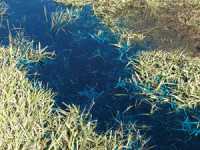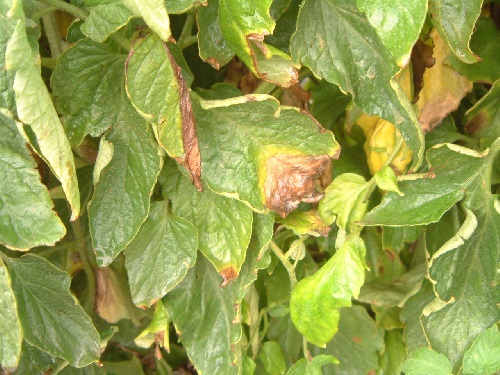Better BMP Implementation

Irrigation Demonstration
The UF/IFAS BMP Implementation Team planned a demonstration to show the effects of over-irrigation on the fate of nitrogen for the Florida Sod BMP Kick-off Event it held at Strickland Sod in New Smyrna Beach. The plan was to put a water-soluble dye (that mimics the movement of water-soluble forms of nitrogen) in a sod field the day prior to the event, water it in, and then dig pits in the sod on the day of the event to show dye distribution in the soil. However, nature did not fully cooperate. Two days before the event, a storm system moved through the area and dumped several inches of rain, saturating the soil. We went ahead with the demonstration, and sprayed a water-soluble dye in two separate areas. A traveling gun was used to apply ½ inch on one of the areas and the other was over-irrigated with 3 inches.
Unexpected Results
Usually, the plot that is over-irrigated will show that the dye has moved down through and beyond the rooting zone. The results of this demonstration were quite interesting in that the usual effect was not observed, but another important lesson was learned. The dye penetrated in both plots to the same depth, about 4 inches. Two factors contributed to this occurrence:
1. The soil was very wet before the demonstration was started, and most of the soil pore spaces were already full of water below the 4-inch depth to which the dye penetrated. When the irrigation water hit the saturated zone, it was not able to penetrate any further and moved laterally towards the drainage ditch.
2. The production field is crowned for drainage purposes (as opposed to being level). Wet field conditions result in excess irrigation or rainfall running off the field.
Important Implications
This demonstration illustrated that when you have crowned fields and soil moisture near field capacity, much of the applied fertilizer can leave the farm via sheet flow regardless of irrigation depth. Although this demonstration was done on a sod farm, producers of other commodities can apply this lesson when making management decisions about fertilization and irrigation under wet soil conditions.
The take-home lessons for growers from this demonstration are as follows:
- Consider land leveling.
- Do not fertilize when you have wet soil conditions.
- Do not fertilize when you expect heavy rainfall.
Additional information on conducting dye tests can be found in the IFAS EDIS Extension document at http://edis.ifas.ufl.edu/HS222. Growers interested in learning more about using dye tests to visualize irrigation can contact their local county Extension office or the UF/IFAS BMP Implementation Team.








